

What Music Really Is, What Is It, and What It Is Not. By Bo Constantinsen, author of WhatMusicReallyIs.com The “Research” section on this website [WhatMusicReallyIs.com] represents the in-the-making process of the What Music Really İs manual as an interactive presentation, book, and featured documentary.
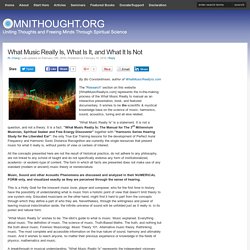
It wishes to be the scientific & mystical knowledge base on the science of music: harmonics, sound, acoustics, tuning and all else related. Natural Music And Where All Music Comes From. By Bo Constantinsen, author of WhatMusicReallyIs.com Music Comes from the Harmonic Series The most common and widely accepted definition of music includes three main elements: rhythm (timing), timbre (nuance) and pitch (height).
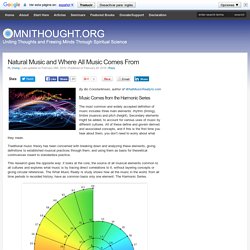
Secondary elements might be added, to account for various uses of music by different cultures. All of these define and govern derived and associated concepts, and if this is the first time you hear about them, you don’t need to worry about what they mean. Traditional music theory has been concerned with breaking down and analyzing these elements, giving definitions to established musical practices through them, and using them as basis for theoretical contrivances meant to standardize practice.
This research goes the opposite way: it looks at the core, the source of all musical elements common to all cultures and explores what music is by tracing direct correlations to it, without layering concepts or giving circular references. Everything You Should Know About Sound. This post is part of Mini Week, where I’m posting a new mini post but not actually mini as it turns out every weekday this week.

I’ve always been a little confused about sound. So for “Tuesday’s” “mini” post, I decided to do something about that. We think of sound as something we hear—something that makes noise. But in pure physics terms, sound is just a vibration going through matter. The way a vibration “goes through” matter is in the form of a sound wave. But that’s not how sound waves work. A sound wave is more like an earthworm situation:
How to Listen to Music: A Vintage Guide to the 7 Essential Skills. By Maria Popova “Respond esthetically to all sounds, from the hum of the refrigerator motor or the paddling of oars on a lake, to the tones of a cello or muted trumpet.”
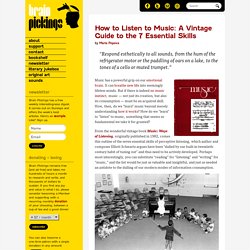
Music has a powerful grip on our emotional brain. Developing a vivid aural imagination. The extent to which your aural imagination is developed, largely determines: the quality of lines you play, how you play those lines (articulation, swing feel, inflection), and the sound you play with.

Nothing has such an impact on your playing than your aural imagination. THE MOZART EFFECT … AND BEYOND. BABBITT EFFECT: Child gibbers nonsense all the time.
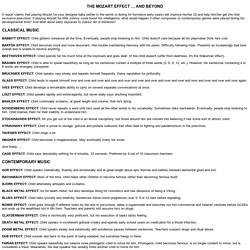
Eventually, people stop listening to him. Child doesn't care because all his playmates think he's cool. BARTÓK EFFECT: Child becomes more and more dissonant. Anedonia musicale: questione di ridotta connettività cerebrale. György ligeti’s artikulation (with score and audio) – The Hum Blog. The A=432 Hz Frequency: DNA Tuning and the Bastardization of Music. Brendan D.

Murphy, Guest GA=440Hz: Not Quite Music to My Ears Humankind is the largely unwitting victim of a frequency war on our consciousness that has been waged for decades, if not millennia. The goal has clearly been to keep us as gullible and subservient as possible, through multifarious means. In modern history in particular, there has been what Dr. The American Federation of Musicians had already accepted the A440 as standard pitch in 1917, and the U.S. government followed suit in 1920. Fibonacci dans l'harmonie - La musique décodée. Fibonacci sequence in music.
The Pinocchio Theory. Boucles de rétroaction et les rythmes de la nature - Anje-Margriet Neutel. The Neuroscience of Bass: New Study Explains Why Bass Instruments Are Fundamental to Music. Photo by Sebastiaan term Burg via Wikimedia Commons At the lower range of hearing, it’s said humans can hear sound down to about 20 Hz, beneath which we encounter a murky sonic realm called “infrasound,” the world of elephant and mole hearing.

But while we may not hear those lowest frequencies, we feel them in our bodies, as we do many sounds in the lower frequency ranges—those that tend to disappear when pumped through tinny earbuds or shopping mall speakers. Since bass sounds don’t reach our ears with the same excited energy as the high frequency sounds of, say, trumpets or wailing guitars, we’ve tended to dismiss the instruments—and players—who hold down the low end (know any famous tuba players?). In most popular music, bass players don’t get nearly enough credit—even when the bass provides a song’s essential hook. Vibrational Modes of Drums. Ear training online and mobile. Ear Trainer. MusicalMind.org Ear Training Online. Free ear training tools for musicians. Jazz Ear Training - Master Your Intervals in 28 Days.
Being able to quickly hear, sing, and accurately identify intervals is essential to developing your improvisational ear.
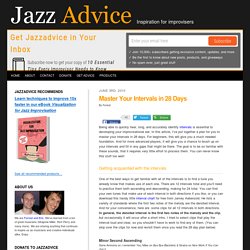
In this article, I’ve put together a plan for you to master your intervals in 28 days. For beginners, this will give you a much needed foundation.